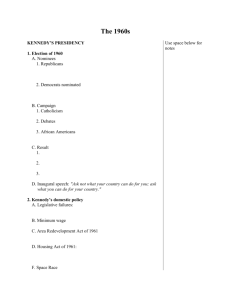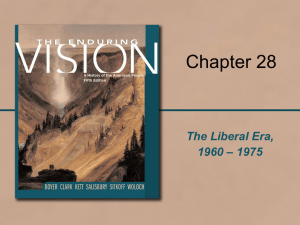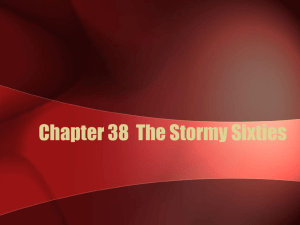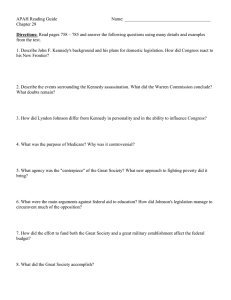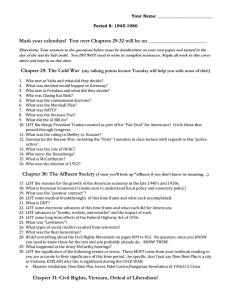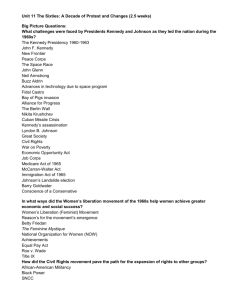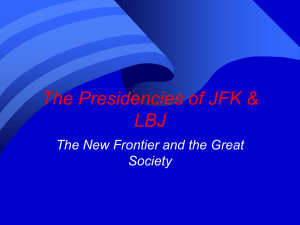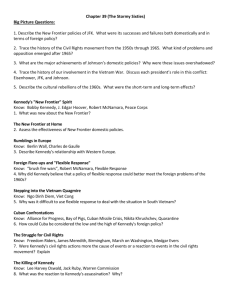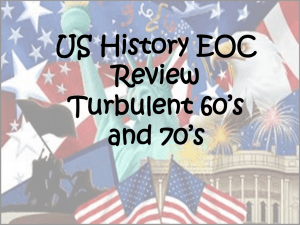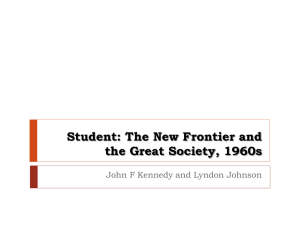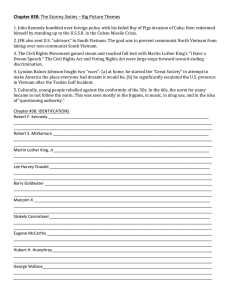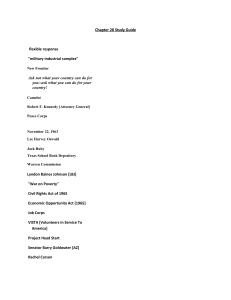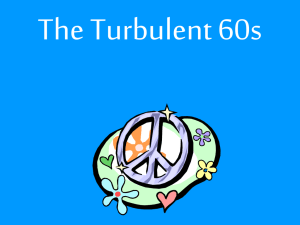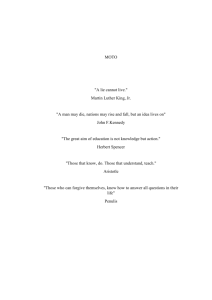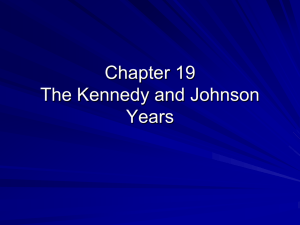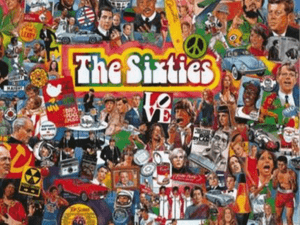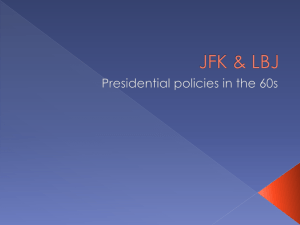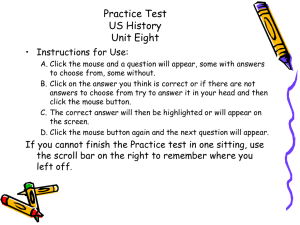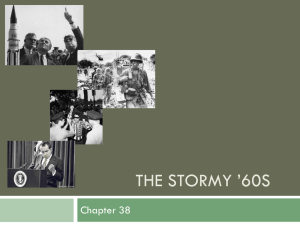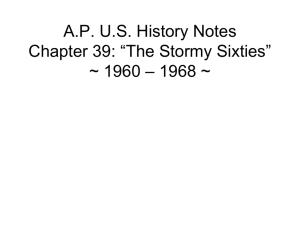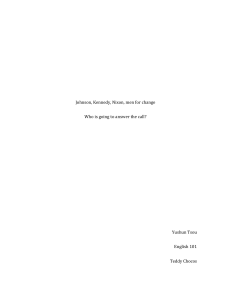Chapter 34: New Frontiers: Politics and Social Change in the 1960s
advertisement
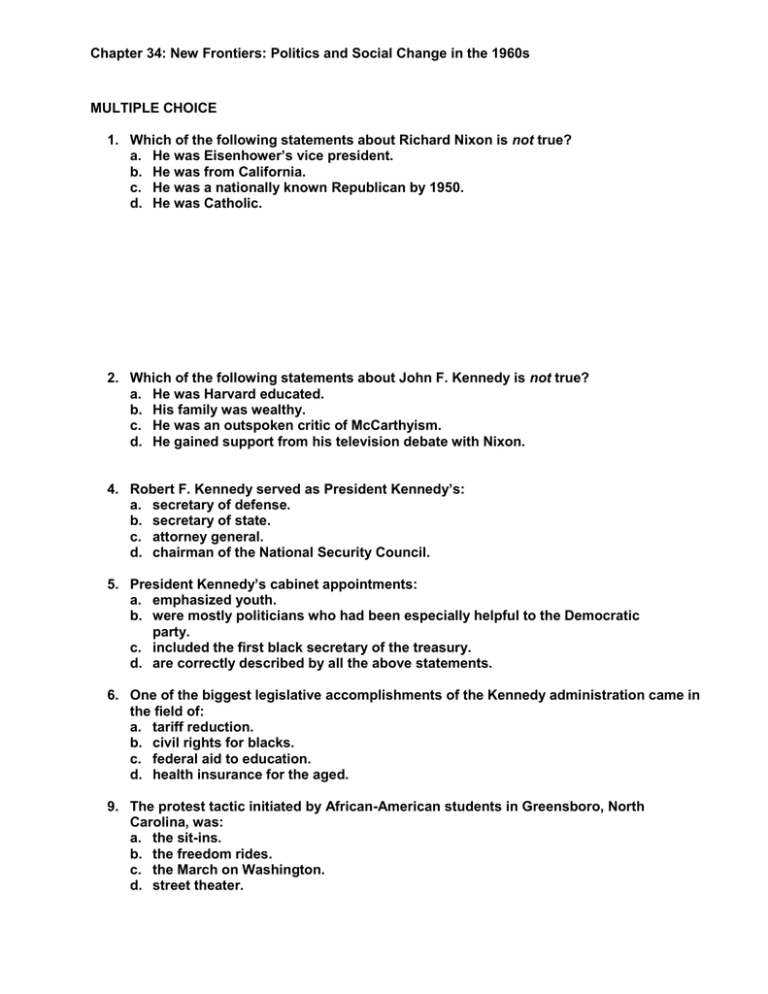
Chapter 34: New Frontiers: Politics and Social Change in the 1960s MULTIPLE CHOICE 1. Which of the following statements about Richard Nixon is not true? a. He was Eisenhower’s vice president. b. He was from California. c. He was a nationally known Republican by 1950. d. He was Catholic. 2. Which of the following statements about John F. Kennedy is not true? a. He was Harvard educated. b. His family was wealthy. c. He was an outspoken critic of McCarthyism. d. He gained support from his television debate with Nixon. 4. Robert F. Kennedy served as President Kennedy’s: a. secretary of defense. b. secretary of state. c. attorney general. d. chairman of the National Security Council. 5. President Kennedy’s cabinet appointments: a. emphasized youth. b. were mostly politicians who had been especially helpful to the Democratic party. c. included the first black secretary of the treasury. d. are correctly described by all the above statements. 6. One of the biggest legislative accomplishments of the Kennedy administration came in the field of: a. tariff reduction. b. civil rights for blacks. c. federal aid to education. d. health insurance for the aged. 9. The protest tactic initiated by African-American students in Greensboro, North Carolina, was: a. the sit-ins. b. the freedom rides. c. the March on Washington. d. street theater. 10. Violence erupted in 1962 when James Meredith attempted to integrate: a. the University of Alabama. b. Louisiana State University. c. Georgia Tech. d. Ole Miss. 11. The philosophy of “militant nonviolence” was best seen in the work of: a. Eldridge Cleaver. b. Martin Luther King Jr. c. H. Rap Brown. d. Huey P. Newton. 13. The March on Washington: a. ended when Jesse Jackson and other civil rights leaders were arrested for parading without a permit. b. was the setting of Jesse Jackson’s “I Have a Dream” speech. c. was the largest civil rights demonstration in American history. d. is correctly represented by all the above statements. 14. In Miranda v. Arizona, the Supreme Court: a. outlawed residential segregation by race. b. ruled that school prayer was unconstitutional. c. confirmed the obligation of police to inform arrested suspects of their rights before questioning. d. ordered the release of a conscientious objector who refused to fight in Vietnam for moral reasons. 16. The Immigration Act of 1965: a. favored immigrants from southern and eastern Europe. b. favored immigrants from northern and western Europe. c. treated all nationalities equally. d. resulted in a tremendous surge of European immigration to the United States. 17. Faced with the presence of Soviet missiles in Cuba, President Kennedy: a. ordered a “surgical” air strike. b. waited to see what the Soviets would do. c. ordered a naval blockade of Cuba. d. broke off diplomatic relations with Cuba. 19. Following the Cuban missile crisis, several steps were taken to ease Soviet-American tensions. These included all the following except: a. a treaty that banned nuclear testing in the atmosphere. b. installation of a “hot line” between Moscow and Washington. c. the halting of construction on the Berlin Wall for several years. d. the removal of obsolete missiles from Turkey, Italy, and Britain. 21. Lyndon Johnson was from: a. Arizona. b. Georgia. c. Pennsylvania. d. Texas. 22. The Other America described the problem of: a. poverty. b. racial discrimination. c. Cuban refugees. d. Native Americans. 23. What relationship did Al Smith have to the 1960 campaign for president? a. He endorsed Richard Nixon. b. He endorsed John F. Kennedy. c. He was the last Catholic to run for president. d. He started a new political party. 24. In the election of 1964: a. Republicans increased their majorities in Congress. b. Lyndon Johnson won by a landslide. c. the race issue helped Johnson win the states of the Deep South. d. Barry Goldwater campaigned on a platform of “peace in Vietnam and civil rights at home.” 25. The health insurance bill passed by Congress in 1965: a. created Medicaid to help cover medical payments for the indigent. b. was opposed by the American Medical Association. c. was vetoed by Johnson because Congress refused to raise taxes to pay for it. d. was ruled unconstitutional by the Supreme Court two years later. 27. The civil rights legislation of 1964 and 1965: a. was passed by Congress over Johnson’s opposition. b. ended black protest movements. c. dramatically expanded black votes in the South. d. made the South more strongly Democratic. 28. Malcolm X: a. said blacks should be proud of their African heritage. b. was killed by a white racist during a speech in Harlem. c. headed the Black Panthers. d. supported the non-violent tactics of Martin Luther King Jr. 29. The Watts riot: a. led to passage the following year of the Voting Rights Act. b. signaled a new phase in the civil rights movement. c. began with the assassination of Martin Luther King Jr. d. is correctly represented by all the above statements. 30. Which of the following was assassinated in 1965? a. Malcolm X b. Robert F. Kennedy c. Martin Luther King Jr. d. all the above 32. Operation “Rolling Thunder” was the: a. code name for Lyndon Johnson’s presidential campaign of 1964. b. code name for Barry Goldwater’s presidential campaign of 1964. c. first major search and destroy operation carried out by American forces in Vietnam. d. first sustained bombing of North Vietnam. 33. During the campaign of 1964, candidate Barry Goldwater proposed: a. the annexation of Cuba. b. the sale of the Tennessee Valley Authority. c. invading the Soviet Union. d. abolition of the Supreme Court. 34. By the end of 1966, middle-class resentment over the cost and waste of the Great Society programs helped to generate: a. a conservative backlash that fueled a Republican resurgence at the polls. b. sympathy for the poor who were being cheated out of their benefits. c. a call for new Democratic party leadership. d. a desire to return to the government of the fifties. 35. All the following promised to seek peace in Vietnam except: a. Hubert H. Humphrey. b. Robert F. Kennedy. c. Curtis LeMay. d. Eugene McCarthy. 36. The presidential candidate of the American Independent party in 1968 was: a. Eugene McCarthy. b. Clark Clifford. c. George Wallace. d. Curtis LeMay. 37. In the election of 1968: a. Richard Nixon won by the largest landslide since 1924. b. Democrats won the Deep South states. c. most of Richard Nixon’s support came from the Northeast. d. Hubert Humphrey was the Democratic candidate for president.
